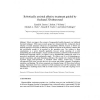Free Online Productivity Tools
i2Speak
i2Symbol
i2OCR
iTex2Img
iWeb2Print
iWeb2Shot
i2Type
iPdf2Split
iPdf2Merge
i2Bopomofo
i2Arabic
i2Style
i2Image
i2PDF
iLatex2Rtf
Sci2ools
CARS
2004
2004
Robotically assisted ablative treatment guided by freehand 3D ultrasound
Robots can improve the accuracy of image-guided needle placement over traditional free-hand techniques. While many research groups have demonstrated this, widespread clinical adoption of needle placement robots has not immediately followed, because 1) Robots are generally expensive and 2) they are difficult to calibrate and register to the patient in a manner fast and user-friendly enough to be practical in the operating room. Our solution to these considerations is a novel, clinically applicable, low-cost system consisting of a robot (manipulating the needle through a surgeon specified trajectory), guided by tracked freehand 3 Dimensional Ultrasound (3DUS). We address cost by algorithmically enabling the robot to be unencoded, uncalibrated, and mechanically simple. We address ease of use by eliminating preoperative registration, and nearly eliminating calibration. The surgical tool is tracked and thereby registered imager intra-operatively. A structured 3DUS volume, created using a tr...
| Added | 30 Oct 2010 |
| Updated | 30 Oct 2010 |
| Type | Conference |
| Year | 2004 |
| Where | CARS |
| Authors | Emad Boctor, Robert J. Webster III, Michael A. Choti, Russell H. Taylor, Gabor Fichtinger |
Comments (0)

